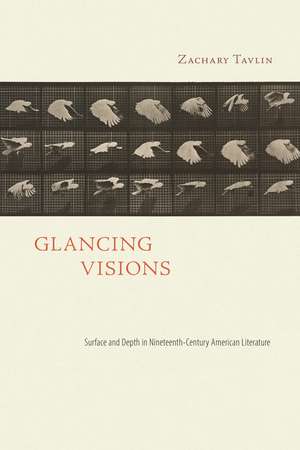Glancing Visions: Surface and Depth in Nineteenth-Century American Literature
Autor Zachary Tavlinen Paperback – 12 iun 2023
How the “glance” rather than the “gaze” in nineteenth-century literature and art anticipates the turn to modernism
The sweeping vantages that typify American landscape painting from the nineteenth century by Thomas Cole and other members of the Hudson River School are often interpreted for their geopolitical connotations, as visual attempts to tame the wild, alleviating fears of a savage frontier through views that subdue the landscape to the eye. But many literary figures of the era display a purposeful disdain for the “possessive gaze,” signaling a preference for subtle glances, often informed by early photography, Impressionism, new techniques in portraiture, and, soon after, the dawn of cinema. The visual subjectivities and contingencies introduced by these media made room for a visual counternarrative, one informed by a mode of seeing that moves fast and lightly across the surface of things.
Tavlin probes Nathaniel Hawthorne’s theory of the imagination at a turning point in the history of photography, when momentary glances take on new narrative potentials. The poetry of Frances Ellen Watkins Harper toggles between gazes and glances, unsettling two competing forms of racialized seeing as they pertain to nineteenth-century Black life and racial hierarchies—the sentimental gaze and the slave trader’s glance—highlighting the life-and-death stakes of looking and looking away. Emily Dickinson’s syntactical oddities and her lifelong process of stitching and unstitching the poems that constitute her corpus all derive from a commitment to immanence associated with animal perception. Tavlin investigates, as well, Henry James’s vexed relationship to painterly Impressionism and William Carlos Williams’s imagist poetics as a response to early cinema’s use of the cut as the basis for a new visual grammar.
Each of these literary artists—via their own distinctive sensibilities and the artistic or technological counterparts that informed them—refuse the authoritative, all-possessive gaze in favor of the glance, a mode of seeing, thinking, and being that made way for the twentieth century’s twist on modernity. Glancing Visions will be of interest to scholars and teachers of American literature and literary history, visual culture, visual theory, aesthetic philosophy, and phenomenology.
The sweeping vantages that typify American landscape painting from the nineteenth century by Thomas Cole and other members of the Hudson River School are often interpreted for their geopolitical connotations, as visual attempts to tame the wild, alleviating fears of a savage frontier through views that subdue the landscape to the eye. But many literary figures of the era display a purposeful disdain for the “possessive gaze,” signaling a preference for subtle glances, often informed by early photography, Impressionism, new techniques in portraiture, and, soon after, the dawn of cinema. The visual subjectivities and contingencies introduced by these media made room for a visual counternarrative, one informed by a mode of seeing that moves fast and lightly across the surface of things.
Tavlin probes Nathaniel Hawthorne’s theory of the imagination at a turning point in the history of photography, when momentary glances take on new narrative potentials. The poetry of Frances Ellen Watkins Harper toggles between gazes and glances, unsettling two competing forms of racialized seeing as they pertain to nineteenth-century Black life and racial hierarchies—the sentimental gaze and the slave trader’s glance—highlighting the life-and-death stakes of looking and looking away. Emily Dickinson’s syntactical oddities and her lifelong process of stitching and unstitching the poems that constitute her corpus all derive from a commitment to immanence associated with animal perception. Tavlin investigates, as well, Henry James’s vexed relationship to painterly Impressionism and William Carlos Williams’s imagist poetics as a response to early cinema’s use of the cut as the basis for a new visual grammar.
Each of these literary artists—via their own distinctive sensibilities and the artistic or technological counterparts that informed them—refuse the authoritative, all-possessive gaze in favor of the glance, a mode of seeing, thinking, and being that made way for the twentieth century’s twist on modernity. Glancing Visions will be of interest to scholars and teachers of American literature and literary history, visual culture, visual theory, aesthetic philosophy, and phenomenology.
Preț: 209.98 lei
Nou
Puncte Express: 315
Preț estimativ în valută:
40.18€ • 42.26$ • 33.57£
40.18€ • 42.26$ • 33.57£
Carte indisponibilă temporar
Doresc să fiu notificat când acest titlu va fi disponibil:
Se trimite...
Preluare comenzi: 021 569.72.76
Specificații
ISBN-13: 9780817360894
ISBN-10: 0817360891
Pagini: 256
Ilustrații: 11
Dimensiuni: 152 x 229 x 23 mm
Greutate: 0.41 kg
Editura: University Of Alabama Press
Colecția University Alabama Press
ISBN-10: 0817360891
Pagini: 256
Ilustrații: 11
Dimensiuni: 152 x 229 x 23 mm
Greutate: 0.41 kg
Editura: University Of Alabama Press
Colecția University Alabama Press
Notă biografică
Zachary Tavlin is adjunct assistant professor in the Department of Liberal Arts at the School of the Art Institute of Chicago. His peer-reviewed scholarship has appeared in Critical Inquiry, Diacritics, ESQ, J19, English, Continental Philosophy Review, and Wallace Stevens Journal, among other places.
Recenzii
“In Glancing Visions, Tavlin makes a compelling and relevant argument that is significant for the fields of visual studies and American studies and for author studies of each of the authors the manuscript treats (Hawthorne, Harper, Dickinson, and James). Tavlin urges scholars to attend to and even prioritize studies of the ‘glance’ within theories of visuality, and this is a perceptive and necessary intervention. The author offers impressive and sophisticated readings of theories of the glance and gaze as well as a range of nineteenth-century authors and texts. It was a joy to find meditations on the glance in texts where I had not seen them, thanks to the close and attentive explications Tavlin provides.”
—Shelly Jarenski, author of Immersive Words: Mass Media, Visuality, and American Literature, 1839–1893
—Shelly Jarenski, author of Immersive Words: Mass Media, Visuality, and American Literature, 1839–1893
Descriere
How the “glance” rather than the “gaze” in nineteenth-century literature and art anticipates the turn to modernism
